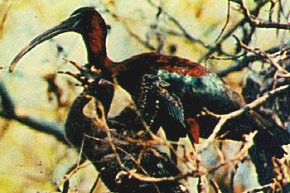 Synonyms: Tantalus
falcinellus Linnaeus, 1766
Synonyms: Tantalus
falcinellus Linnaeus, 1766Plegadis falcinellus Linnaeus, 1766
 Synonyms: Tantalus
falcinellus Linnaeus, 1766
Synonyms: Tantalus
falcinellus Linnaeus, 1766
Common names: Bulg: Blestyach ibis; Engl: Glossy ibis; Rom: Tiganus; Russ: Karavayka; Turk: Celtikci; Ukr: Korovayka
Order: CICONIIFORMES
Family: THRESKIORNITHIDAE
Taxonomic descriptions: 1500-2000 pairs.
 IUCN Status:
IUCN Status:
World level: LR
Black Sea Regional level: LR
Subregion level: LR
Distribution:
Habitats type, Critical habitats, Limiting factors: Dense reed-beds in brackish and fresh water-bodies, arboreal or bush vegetation of flood-plains. Breeding and feeding habitats are alike, but it most frequently forages on fresh or freshened shallow waters, rice fields. Major limiting factors include disturbance in the colonies, water pollution and a decrease in habitat feeding capacity.
Biology: Arrival at the end of March - beginning of April. The terms of egg-laying vary annually and topographically within the colony, but most are laid between 20.04 and 26.05. Separate sub-colonies of Glossy Ibis are located in mixed colonies of other herons. Nesting density is high. Usually the nests take the lowest level (up to 0.4 m over the water). When nesting on bushes and trees, the height may be more variable, but these habitats do not play a key role in the region. Clutch size 2-7, normally 4-5 eggs. After fledging juveniles move in various directions. Sometimes birds stay in the breeding area till late September. Departure to wintering grounds is in October.
Population trends:
Threats: Water pollution of shallow bays degrading the reed-beds, melioration of downstream riverine areas, human disturbance.
Conservation measures taken: Colonies of Plegadis falcinellus are protected in the Danube Delta.
Conservation measures proposed: Obligatory protection of all breeding colonies.
References:
Compiled by: V.Siokhin